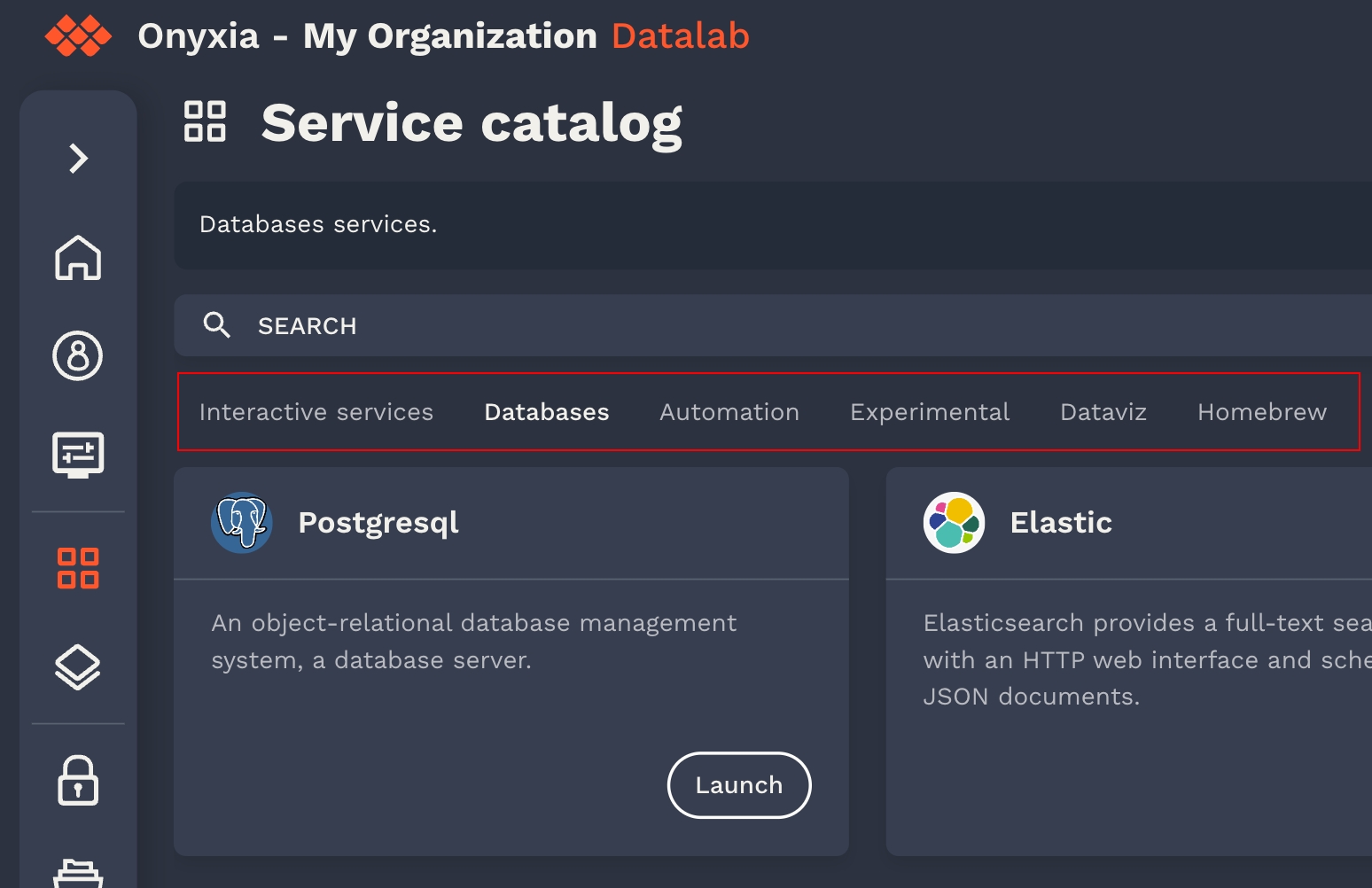🔬Catalog of services
Unserstand how Onyxia catalogs work and potentially create your own!
Every Onyxia instance may or may not have it's own catalog. There are four default catalogs :
This collection of charts helps users to launch many IDE with various binary stacks (python , R) with or without GPU support. Docker images are built here and help us to give a homogeneous stack.
This collection of charts helps users to launch many databases system. Most of them are based on bitnami/charts.
This collection of charts helps users to start automation tools for their datascience activity.
This collection of charts helps users to launch tools to visualize and share data insights.
You can always find the source of the catalog by clicking on the "contribute to the... " link.
If you take this other instance, it has only one catalog, helm-charts-sill.
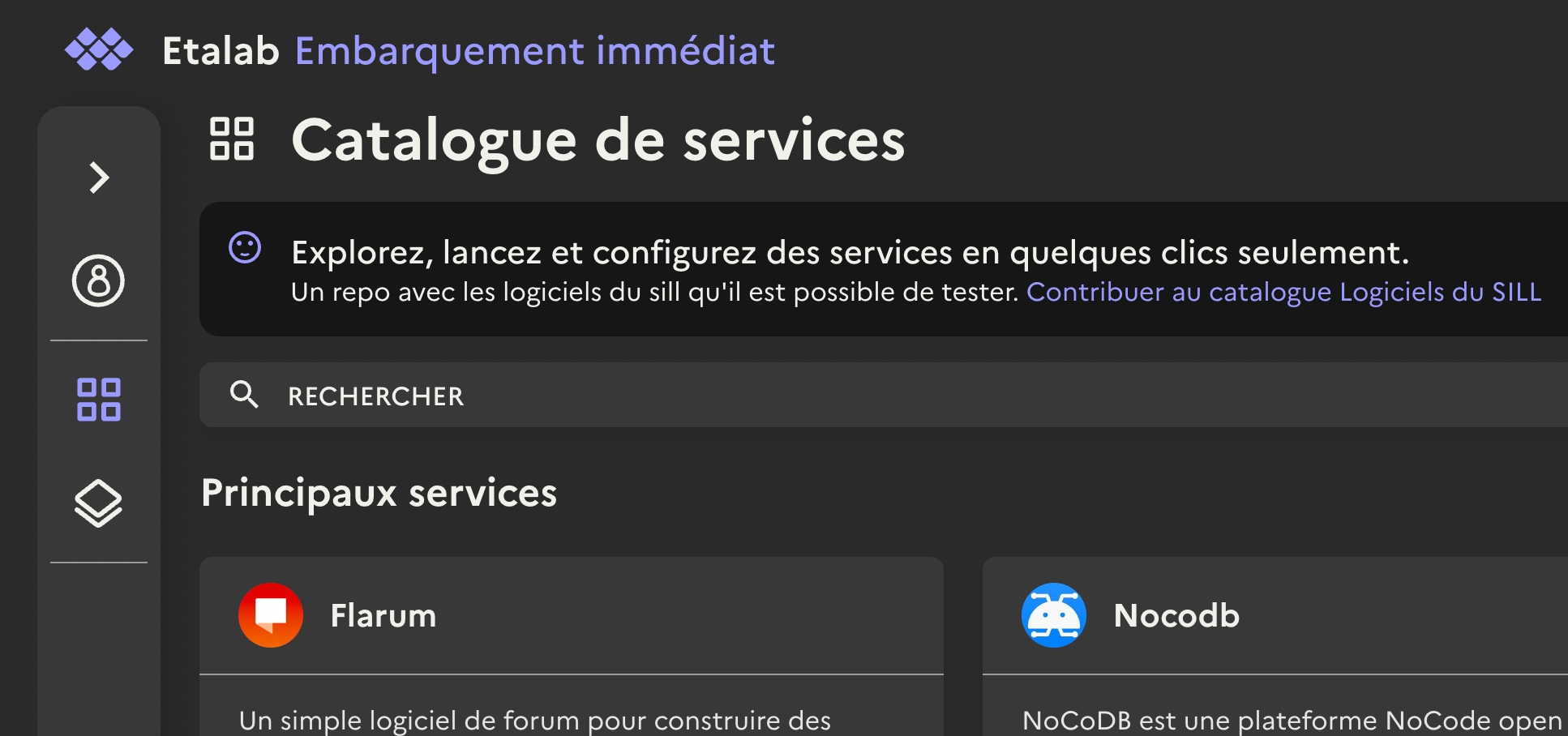
Using your own catalogs (helm charts repositories)
If you do not specify catalogs in your onyxia/values.yaml, these are the ones that are used by default: See file.
To configure your onyxia instance to use your own custom helm repositories as onyxia catalogs you need to use the onyxia configuration onyxia.api.catalogs.
Let's say we're NASA and we want to have an "Areospace services" catalog on our onyxia instance. Our onyxia configuration would look a bit like this:
onyxia:
web:
# ...
api:
# ...
catalogs: [
{
type: "helm",
id: "aerospace",
# The url of the Helm chart repository
location: "https://myorg.github.io/helm-charts-aerospace/",
# Display under the search bar as selection tab:
# https://github.com/InseeFrLab/onyxia/assets/6702424/a7247c7d-b0be-48db-893b-20c9352fdb94
name: {
en: "Aerospace services",
fr: "Services aérospatiaux"
# ... other languages your instance supports
},
# Optional. Defines the chart that should appear first
highlightedCharts: ["jupyter-artemis", "rstudio-dragonfly"],
# Optional. Defines the chart that should be excluded
excludedCharts: ["a-vendor-locking-chart"],
# Optional, If defined, displayed in the header of the catalog page:
# https://github.com/InseeFrLab/onyxia/assets/6702424/57e32f44-b889-41b2-b0c7-727c35b07650
# Is rendered as Markdown
description: {
en: "A catalog of services for aerospace engineers",
fr: "Un catalogue de services pour les ingénieurs aérospatiaux"
# ...
},
# Can be "PROD" or "TEST". If test the catalogs will be accessible if you type the url in the search bar
# but you won't have a tab to select it.
status": "PROD",
# Optional. If true the certificate verification for `${location}/index.yaml` will be skipped.
skipTlsVerify: false,
# Optional. certificate authority file to use for the TLS verification
caFile: "/path/to/ca.crt",
# Optional: Enables you to a specific group of users.
# You can match any claim in the JWT token.
# If the claim's value is an array, it match if one of the value is the one you specified.
# The match property can also be a regex.
restrictions: [
{
userAttribute: {
key: "groups",
matches: "nasa-engineers"
}
}
]
},
# { ... } another catalog
]Customizing your helm charts for Onyxia
In Onyxia we use the values.schema.json file to know what options should be displayed to the user at the service configuration step and what default value Onyxia should inject.
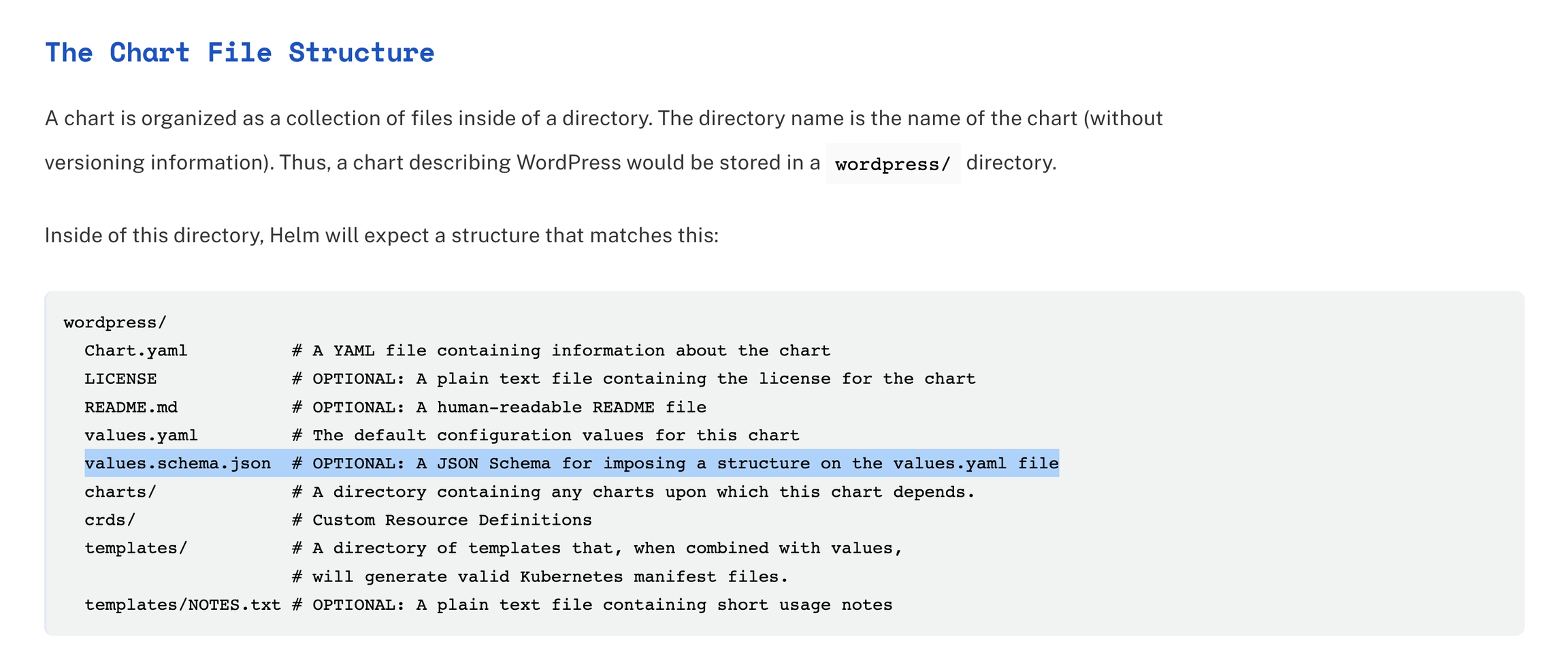
[x-onyxia] overwriteDefaultWith
Let's consider a sample of the values.schema.json of the InseeFrLab/helm-charts-interactive-services' Jupyter chart:
"git": {
"description": "Git user configuration",
"type": "object",
"properties": {
"enabled": {
"type": "boolean",
"description": "Add git config inside your environment",
"default": true
},
"name": {
"type": "string",
"description": "user name for git",
"default": "",
"x-onyxia": {
"overwriteDefaultWith": "git.name"
},
"hidden": {
"value": false,
"path": "git/enabled"
}
},
"email": {
"type": "string",
"description": "user email for git",
"default": "",
"x-onyxia": {
"overwriteDefaultWith": "git.email"
},
"hidden": {
"value": false,
"path": "git/enabled"
}
},
"cache": {
"type": "string",
"description": "duration in seconds of the credentials cache duration",
"default": "",
"x-onyxia": {
"overwriteDefaultWith": "git.credentials_cache_duration"
},
"hidden": {
"value": false,
"path": "git/enabled"
}
},
"token": {
"type": "string",
"description": "personal access token",
"default": "",
"x-onyxia": {
"overwriteDefaultWith": "git.token"
},
"hidden": {
"value": false,
"path": "git/enabled"
}
},
"repository": {
"type": "string",
"description": "Repository url",
"default": "",
"hidden": {
"value": false,
"path": "git/enabled"
}
},
"branch": {
"type": "string",
"description": "Brach automatically checkout",
"default": "",
"hidden": {
"value": "",
"path": "git/repository"
}
}
}
},And it translates into this:
Note the "git.name", "git.email" and "git.token", this enables onyxia-web to pre fill the fields.
If the user took the time to fill its profile information, onyxia-web knows what is the Git username, email and personal access token of the user.
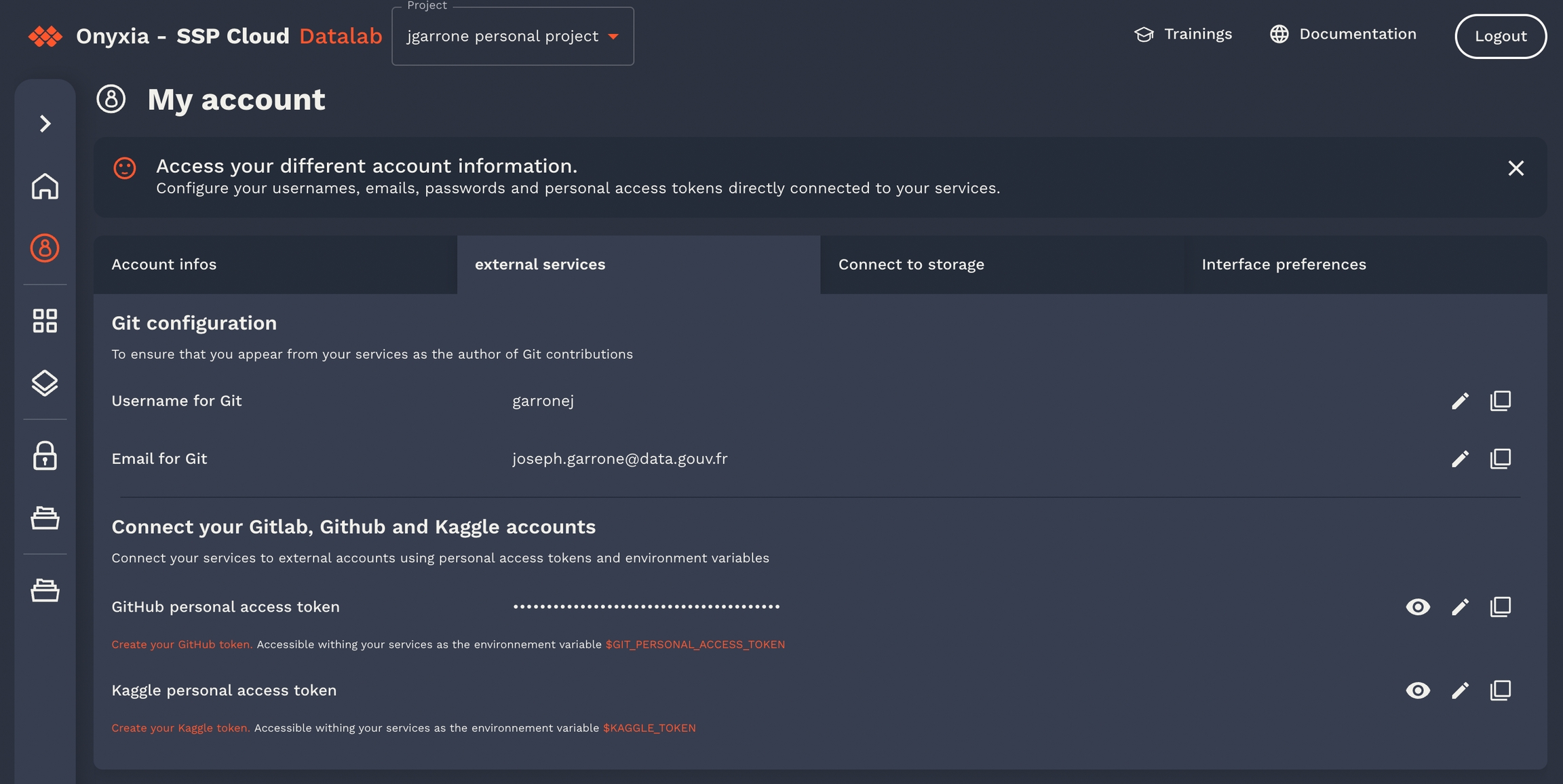
Here is defined the structure of the context that you can use in the overwriteDefaultWith field:
export type XOnyxiaParams = {
/**
* This is where you can reference values from the onyxia context so that they
* are dynamically injected by the Onyxia launcher.
*
* Examples:
* "overwriteDefaultWith": "user.email" ( You can also write "{{user.email}}" it's equivalent )
* "overwriteDefaultWith": "{{project.id}}-{{k8s.randomSubdomain}}.{{k8s.domain}}"
* "overwriteDefaultWith": [ "a hardcoded value", "some other hardcoded value", "{{region.oauth2.clientId}}" ]
* "overwriteDefaultWith": { "foo": "bar", "bar": "{{region.oauth2.clientId}}" }
*
*/
overwriteDefaultWith?:
| string
| number
| boolean
| unknown[]
| Record<string, unknown>;
overwriteListEnumWith?: unknown[] | string;
hidden?: boolean;
readonly?: boolean;
useRegionSliderConfig?: string;
};
export type XOnyxiaContext = {
user: {
idep: string;
name: string;
email: string;
password: string;
ip: string;
darkMode: boolean;
lang: "en" | "fr" | "zh-CN" | "no" | "fi" | "nl" | "it" | "es" | "de";
/**
* Decoded JWT OIDC ID token of the user launching the service.
*
* Sample value:
* {
* "sub": "9000ffa3-5fb8-45b5-88e4-e2e869ba3cfa",
* "name": "Joseph Garrone",
* "aud": ["onyxia", "minio-datanode"],
* "groups": [
* "USER_ONYXIA",
* "codegouv",
* "onyxia",
* "sspcloud-admin",
* ],
* "preferred_username": "jgarrone",
* "given_name": "Joseph",
* "locale": "en",
* "family_name": "Garrone",
* "email": "[email protected]",
* "policy": "stsonly",
* "typ": "ID",
* "azp": "onyxia",
* "email_verified": true,
* "realm_access": {
* "roles": ["offline_access", "uma_authorization", "default-roles-sspcloud"]
* }
* }
*/
decodedIdToken: Record<string, unknown>;
accessToken: string;
refreshToken: string;
};
service: {
oneTimePassword: string;
};
project: {
id: string;
password: string;
basic: string;
};
git: {
name: string;
email: string;
credentials_cache_duration: number;
token: string | undefined;
};
vault: {
VAULT_ADDR: string;
VAULT_TOKEN: string;
VAULT_MOUNT: string;
VAULT_TOP_DIR: string;
};
s3: {
AWS_ACCESS_KEY_ID: string;
AWS_SECRET_ACCESS_KEY: string;
AWS_SESSION_TOKEN: string;
AWS_DEFAULT_REGION: string;
AWS_S3_ENDPOINT: string;
AWS_BUCKET_NAME: string;
port: number;
pathStyleAccess: boolean;
/**
* The user is assumed to have read/write access on every
* object starting with this prefix on the bucket
**/
objectNamePrefix: string;
/**
* Only for making it easier for charts editors.
* <AWS_BUCKET_NAME>/<objectNamePrefix>
* */
workingDirectoryPath: string;
/**
* If true the bucket's (directory) should be accessible without any credentials.
* In this case s3.AWS_ACCESS_KEY_ID, s3.AWS_SECRET_ACCESS_KEY and s3.AWS_SESSION_TOKEN
* will be empty strings.
*/
isAnonymous: boolean;
};
region: {
defaultIpProtection: boolean | undefined;
defaultNetworkPolicy: boolean | undefined;
allowedURIPattern: string;
customValues: Record<string, unknown> | undefined;
kafka:
| {
url: string;
topicName: string;
}
| undefined;
tolerations: unknown[] | undefined;
from: unknown[] | undefined;
nodeSelector: Record<string, unknown> | undefined;
startupProbe: Record<string, unknown> | undefined;
sliders: Record<
string,
{
sliderMin: number;
sliderMax: number;
sliderStep: number;
sliderUnit: string;
}
>;
resources:
| {
cpuRequest?: `${number}${string}`;
cpuLimit?: `${number}${string}`;
memoryRequest?: `${number}${string}`;
memoryLimit?: `${number}${string}`;
disk?: `${number}${string}`;
gpu?: `${number}`;
}
| undefined;
};
k8s: {
domain: string;
ingressClassName: string | undefined;
ingress: boolean | undefined;
route: boolean | undefined;
istio:
| {
enabled: boolean;
gateways: string[];
}
| undefined;
randomSubdomain: string;
initScriptUrl: string;
useCertManager: boolean;
certManagerClusterIssuer: string | undefined;
};
proxyInjection:
| {
enabled: string | undefined;
httpProxyUrl: string | undefined;
httpsProxyUrl: string | undefined;
noProxy: string | undefined;
}
| undefined;
packageRepositoryInjection:
| {
cranProxyUrl: string | undefined;
condaProxyUrl: string | undefined;
packageManagerUrl: string | undefined;
pypiProxyUrl: string | undefined;
}
| undefined;
certificateAuthorityInjection:
| {
cacerts: string | undefined;
pathToCaBundle: string | undefined;
}
| undefined;
};You can also concatenate string values using by wrapping the XOnyxia targeted values in {{}}.
"hostname": {
"type": "string",
"form": true,
"title": "Hostname",
"x-onyxia": {
"overwriteDefaultWith": "{{project.id}}-{{k8s.randomSubdomain}}.{{k8s.domain}}"
}
}[x-onyxia] overwriteListEnumWith
This is an option for customizing the options of the forms fields rendered as select.
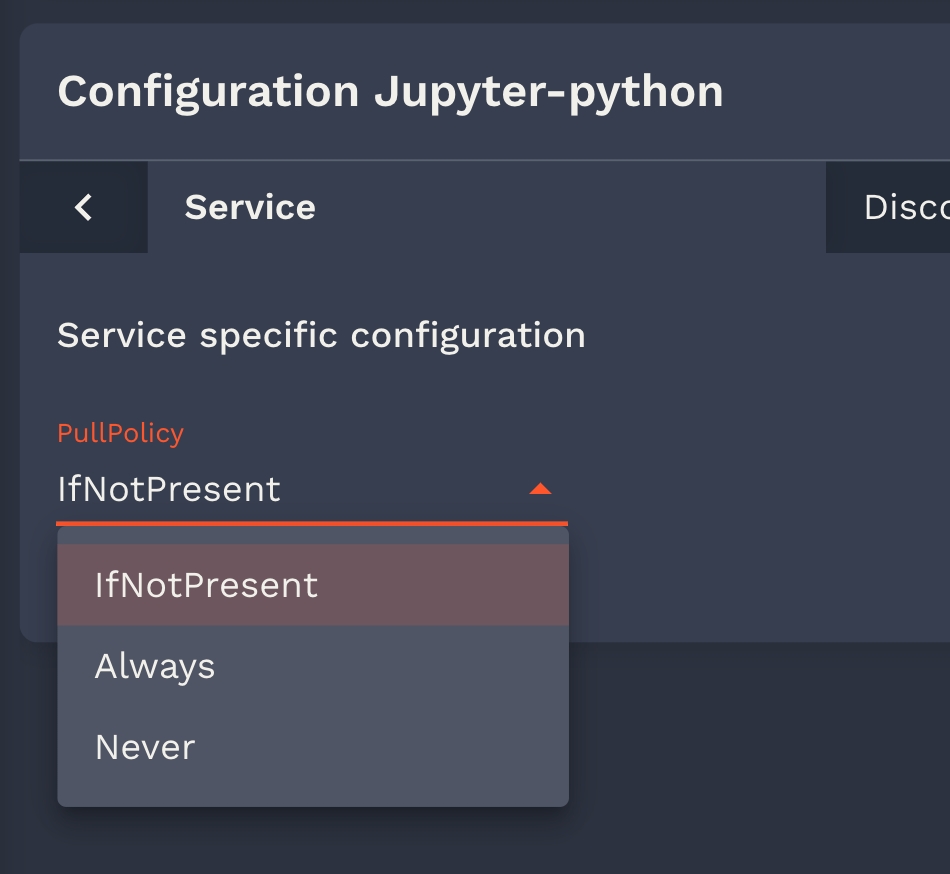
In your values shema such a field would be defined like:
"pullPolicy": {
"type": "string",
"default": "IfNotPresent",
"listEnum": [
"IfNotPresent",
"Always",
"Never"
]
}But what if you want to dynamically generate the option? For this you can use the overwriteListEnumWith x-onyxia option. For example if you need to let the user select one of the groups he belongs to you can write:
"group": {
"type": "string",
"default": "",
"listEnum": [""],
"x-onyxia": {
"overwriteDefaultWith": "user.decodedIdToken.groups[0]",
"overwriteListEnumWith": "user.decodedIdToken.groups"
}
}[x-onyxia] overwriteSchemaWith
Certain elements of a Helm chart should be customized for each instance of Onyxia, such as resource requests and limits, node selectors and tolerations. For this purpose, chart developers can use x-onyxia.overwriteSchemaWith to allow administrators to override specific parts of the schema. Our default charts use this specification.
"nodeSelector": {
"type": "object",
"description": "NodeSelector",
"default": {},
"x-onyxia": {
"overwriteSchemaWith": "nodeSelector.json"
}
}You can see here the list of default schemas included in the Onyxia API. We also provide examples demonstrating how you can customize your services using our interactive services charts with the provided schemas.
The following node selector schema provided by Onyxia API is a generic definition, which may not provide the best experience for a specific Kubernetes cluster in Onyxia.
{
"$schema": "http://json-schema.org/draft-07/schema#",
"title": "Node Selector",
"type": "object",
"description": "Node selector constraints for the pod",
"additionalProperties": {
"type": "string",
"description": "Key-value pairs to select nodes"
}
}As an administrator of Onyxia, you can provide your own schemas to refine and restrict the initial schemas provided in the Helm chart.
node selectors
You can provide this schema to allow your users to choose between SSD or HDD disk types, and A2 or H100 NVIDIA GPUs. Any other values or labels are disallowed, and Onyxia will reject starting a service that does not comply with the provided schema.
{
"$schema": "http://json-schema.org/draft-07/schema#",
"title": "Node Selector",
"type": "object",
"properties": {
"disktype": {
"description": "The type of disk",
"type": "string",
"enum": ["ssd", "hdd"]
},
"gpu": {
"description": "The type of GPU",
"type": "string",
"enum": ["A2", "H100"]
}
},
"additionalProperties": false //any other label is disallowed
}rolebindings for IDE pods
This is the default role for IDE pods in our charts. It is very permissive, and you may want to restrict it to view-only access.
{
"$schema": "http://json-schema.org/draft-07/schema#",
"title": "Role",
"type": "object",
"properties": {
"enabled": {
"type": "boolean",
"description": "allow your service to access your namespace ressources",
"default": true
},
"role": {
"type": "string",
"description": "bind your service account to this kubernetes default role",
"default": "view",
"enum": [
"view",
"edit",
"admin"
]
}
}
}
Here is the refined version
{
"$schema": "http://json-schema.org/draft-07/schema#",
"title": "Role",
"type": "object",
"properties": {
"enabled": {
"type": "boolean",
"const": true,
"description": "This value must always be true, allowing your service to access your namespace resources."
},
"role": {
"type": "string",
"const": "view",
"description": "This value must always be 'view', binding your service account to this Kubernetes default role.",
}
}
}
resources for IDE
You may want to modify the slide bar for resources
{
"$schema": "http://json-schema.org/draft-07/schema#",
"title": "Resources",
"description": "Your service will have at least the requested resources and never more than its limits. No limit for a resource and you can consume everything left on the host machine.",
"type": "object",
"properties": {
"requests": {
"description": "Guaranteed resources",
"type": "object",
"properties": {
"cpu": {
"description": "The amount of cpu guaranteed",
"title": "CPU",
"type": "string",
"default": "100m",
"render": "slider",
"sliderMin": 50,
"sliderMax": 40000,
"sliderStep": 50,
"sliderUnit": "m",
"sliderExtremity": "down",
"sliderExtremitySemantic": "guaranteed",
"sliderRangeId": "cpu"
},
"memory": {
"description": "The amount of memory guaranteed",
"title": "memory",
"type": "string",
"default": "2Gi",
"render": "slider",
"sliderMin": 1,
"sliderMax": 200,
"sliderStep": 1,
"sliderUnit": "Gi",
"sliderExtremity": "down",
"sliderExtremitySemantic": "guaranteed",
"sliderRangeId": "memory"
}
}
},
"limits": {
"description": "max resources",
"type": "object",
"properties": {
"cpu": {
"description": "The maximum amount of cpu",
"title": "CPU",
"type": "string",
"default": "30000m",
"render": "slider",
"sliderMin": 50,
"sliderMax": 40000,
"sliderStep": 50,
"sliderUnit": "m",
"sliderExtremity": "up",
"sliderExtremitySemantic": "Maximum",
"sliderRangeId": "cpu"
},
"memory": {
"description": "The maximum amount of memory",
"title": "Memory",
"type": "string",
"default": "50Gi",
"render": "slider",
"sliderMin": 1,
"sliderMax": 200,
"sliderStep": 1,
"sliderUnit": "Gi",
"sliderExtremity": "up",
"sliderExtremitySemantic": "Maximum",
"sliderRangeId": "memory"
}
}
}
}
}
{
"$schema": "http://json-schema.org/draft-07/schema#",
"title": "Resources",
"description": "Your service will have at least the requested resources and never more than its limits. No limit for a resource and you can consume everything left on the host machine.",
"type": "object",
"properties": {
"requests": {
"description": "Guaranteed resources",
"type": "object",
"properties": {
"cpu": {
"description": "The amount of cpu guaranteed",
"title": "CPU",
"type": "string",
"default": "100m",
"render": "slider",
"sliderMin": 50,
"sliderMax": 10000,
"sliderStep": 50,
"sliderUnit": "m",
"sliderExtremity": "down",
"sliderExtremitySemantic": "guaranteed",
"sliderRangeId": "cpu"
},
"memory": {
"description": "The amount of memory guaranteed",
"title": "memory",
"type": "string",
"default": "2Gi",
"render": "slider",
"sliderMin": 1,
"sliderMax": 200,
"sliderStep": 1,
"sliderUnit": "Gi",
"sliderExtremity": "down",
"sliderExtremitySemantic": "guaranteed",
"sliderRangeId": "memory"
}
}
},
"limits": {
"description": "max resources",
"type": "object",
"properties": {
"cpu": {
"description": "The maximum amount of cpu",
"title": "CPU",
"type": "string",
"default": "5000m",
"render": "slider",
"sliderMin": 50,
"sliderMax": 10000,
"sliderStep": 50,
"sliderUnit": "m",
"sliderExtremity": "up",
"sliderExtremitySemantic": "Maximum",
"sliderRangeId": "cpu"
},
"memory": {
"description": "The maximum amount of memory",
"title": "Memory",
"type": "string",
"default": "50Gi",
"render": "slider",
"sliderMin": 1,
"sliderMax": 200,
"sliderStep": 1,
"sliderUnit": "Gi",
"sliderExtremity": "up",
"sliderExtremitySemantic": "Maximum",
"sliderRangeId": "memory"
}
}
}
}
}How to overwrite a schema or create a new one ?
You can directly create file in the values of onyxia helm charts
onyxia:
web:
# ...
api:
# ...
schemas:
enabled: true
files:
- relativePath: ide/resources.json
content: |
{
"$schema": "http://json-schema.org/draft-07/schema#",
"title": "Resources",
"description": "Your service will have at least the requested resources and never more than its limits. No limit for a resource and you can consume everything left on the host machine.",
"type": "object",
"properties": {
"requests": {
"description": "Guaranteed resources",
"type": "object",
"properties": {
"cpu": {
"description": "The amount of cpu guaranteed",
"title": "CPU",
"type": "string",
"default": "100m",
"render": "slider",
"sliderMin": 50,
"sliderMax": 10000,
"sliderStep": 50,
"sliderUnit": "m",
"sliderExtremity": "down",
"sliderExtremitySemantic": "guaranteed",
"sliderRangeId": "cpu"
},
"memory": {
"description": "The amount of memory guaranteed",
"title": "memory",
"type": "string",
"default": "2Gi",
"render": "slider",
"sliderMin": 1,
"sliderMax": 200,
"sliderStep": 1,
"sliderUnit": "Gi",
"sliderExtremity": "down",
"sliderExtremitySemantic": "guaranteed",
"sliderRangeId": "memory"
}
}
},
"limits": {
"description": "max resources",
"type": "object",
"properties": {
"cpu": {
"description": "The maximum amount of cpu",
"title": "CPU",
"type": "string",
"default": "5000m",
"render": "slider",
"sliderMin": 50,
"sliderMax": 10000,
"sliderStep": 50,
"sliderUnit": "m",
"sliderExtremity": "up",
"sliderExtremitySemantic": "Maximum",
"sliderRangeId": "cpu"
},
"memory": {
"description": "The maximum amount of memory",
"title": "Memory",
"type": "string",
"default": "50Gi",
"render": "slider",
"sliderMin": 1,
"sliderMax": 200,
"sliderStep": 1,
"sliderUnit": "Gi",
"sliderExtremity": "up",
"sliderExtremitySemantic": "Maximum",
"sliderRangeId": "memory"
}
}
}
}
}
- relativePath: nodeSelector.json
content: |
{
"$schema": "http://json-schema.org/draft-07/schema#",
"title": "Node Selector",
"type": "object",
"properties": {
"disktype": {
"description": "The type of disk",
"type": "string",
"enum": ["ssd", "hdd"]
},
"gpu": {
"description": "The type of GPU",
"type": "string",
"enum": ["A2", "H100"]
}
},
"additionalProperties": false
}
- relativePath: ide/role.json
content: |
{
"$schema": "http://json-schema.org/draft-07/schema#",
"title": "Role",
"type": "object",
"properties": {
"enabled": {
"type": "boolean",
"description": "allow your service to access your namespace ressources",
"default": true
},
"role": {
"type": "string",
"description": "bind your service account to this kubernetes default role",
"default": "view",
"hidden": {
"value": false,
"path": "kubernetes/enabled"
},
"enum": [
"view"
]
}
}
}Last updated
Was this helpful?
